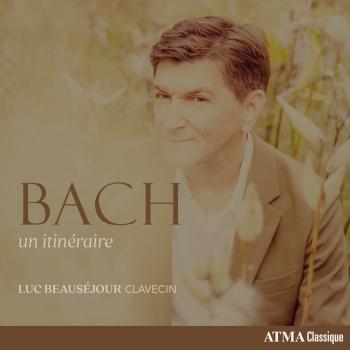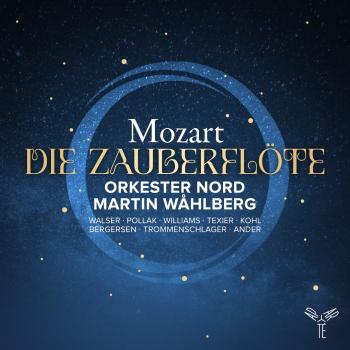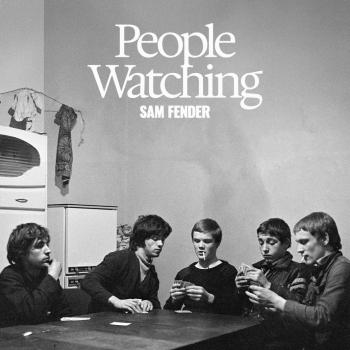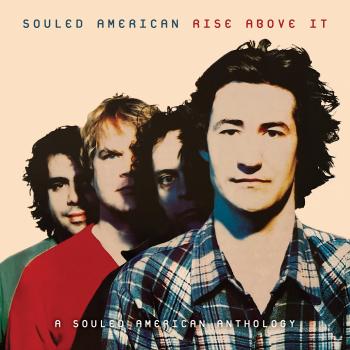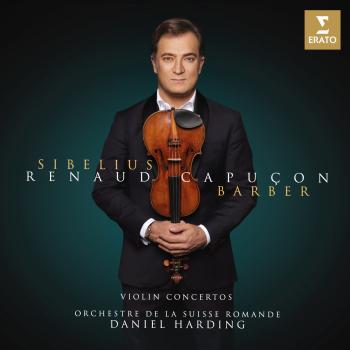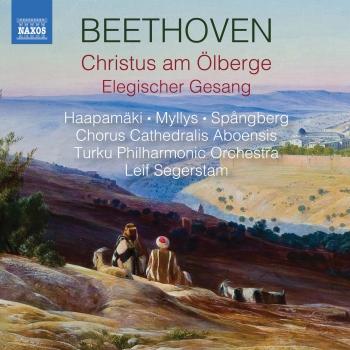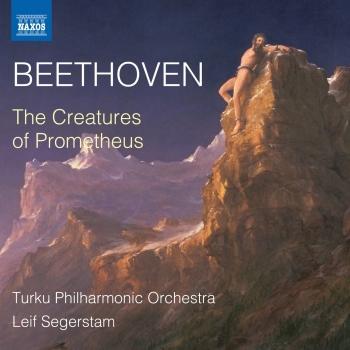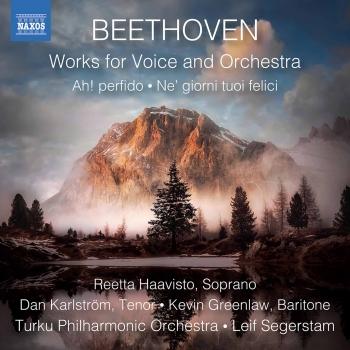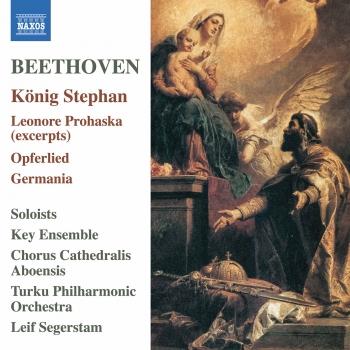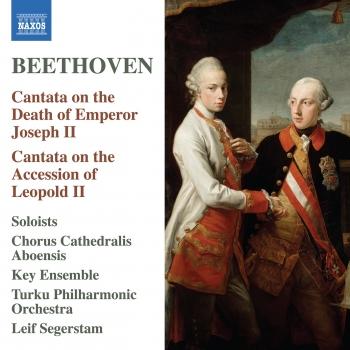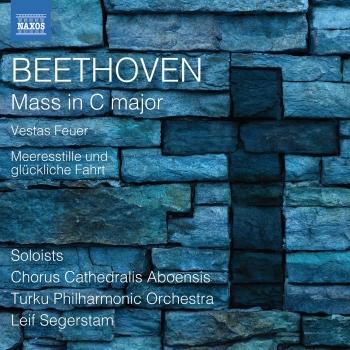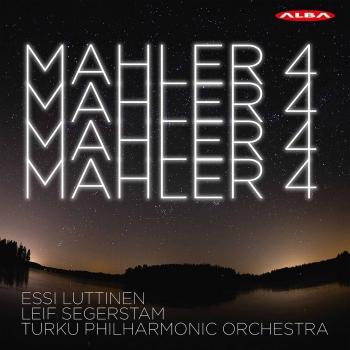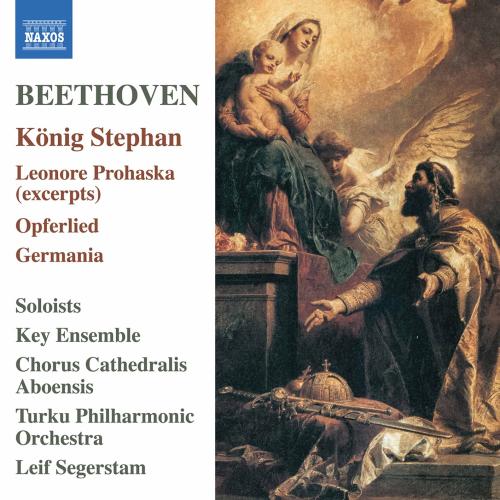
Beethoven: König Stephan & Other Choral Works Turku Philharmonic Orchestra & Leif Segerstam
Album info
Album-Release:
2020
HRA-Release:
10.01.2020
Label: Naxos
Genre: Classical
Subgenre: Vocal
Artist: Turku Philharmonic Orchestra & Leif Segerstam
Composer: Ludwig van Beethoven (1770–1827)
Album including Album cover Booklet (PDF)
- Ludwig van Beethoven (1770 - 1827): König Stephan, Op. 117:
- 1 König Stephan, Op. 117: Overture 07:01
- 2 König Stephan, Op. 117: No. 1, Ruhend von seinen Taten 02:37
- 3 König Stephan, Op. 117: Seid mir gegrüsst an dieses Thrones Stufen 01:52
- 4 König Stephan, Op. 117: No. 2, Auf dunkelm Irrweg in finstern Hainen 01:08
- 5 König Stephan, Op. 117: Fürst! Mich sandten die Edlen im Heere 00:48
- 6 König Stephan, Op. 117: No. 3, Siegesmarsch. Feurig und stolz 03:26
- 7 König Stephan, Op. 117: Ihr tapfern Krieger, Ungarns Stolz und Zierde 03:00
- 8 König Stephan, Op. 117: No. 4, Wo die Unschuld Blumen streute 02:42
- 9 König Stephan, Op. 117: No. 5, Du hast Dein Vaterland 00:53
- 10 König Stephan, Op. 117: No. 6, Eine neue strahlende Sonne 00:43
- 11 König Stephan, Op. 117: No. 7a, Ihr edlen Ungarn! 00:22
- 12 König Stephan, Op. 117: Werft einen Blick in die Vergangenheit 01:49
- 13 König Stephan, Op. 117: No. 7b, Andante con moto 00:40
- 14 König Stephan, Op. 117: Empfanget sie aus Eures Fürsten Händen 00:27
- 15 König Stephan, Op. 117: No. 7c, Maestoso con moto 00:27
- 16 König Stephan, Op. 117: No. 8a, Geistlicher Marsch. Moderato 02:39
- 17 König Stephan, Op. 117: In der schönsten Deiner Lebensstunden 00:22
- 18 König Stephan, Op. 117: No. 8b, Heil unserm Könige - Melodrama. Ich schmücke ehrfurchtsvoll mein Haupt mit dieser Krone 00:23
- 19 König Stephan, Op. 117: No. 8c, Heil unserm Könige 00:17
- 20 König Stephan, Op. 117: No. 8d, Sie bleibe ewig unverletzlich 01:18
- 21 König Stephan, Op. 117: No. 8e, Da steigen sie herauf die edlen Fürsten 02:22
- 22 König Stephan, Op. 117: No. 8f, Umsonst will Zwietracht ihren Bogen spannen 01:37
- 23 König Stephan, Op. 117: No. 9, Heil unsern Enkeln! 02:11
- Leonore Prohaska, WoO 96 (Excerpts):
- 24 Leonore Prohaska, WoO 96 (Excerpts): No. 1, Wir bauen und sterben 02:24
- 25 Leonore Prohaska, WoO 96 (Excerpts): No. 2, Es blüht eine Blume 03:02
- Ludwig van Beethoven:
- 26 Opferlied, Op. 121b 05:41
- 27 Bundeslied, Op. 122 "In allen guten Stunden" 04:38
- 28 Opferlied, Op. 121b (Version for 3 Voices, Choir & Orchestra) 07:18
- 29 Ihr weisen Gründer, WoO 95 01:51
- 30 Germania, WoO 94 05:04
- 31 Es ist Vollbracht, WoO 97 04:22
Info for Beethoven: König Stephan & Other Choral Works
Aside from his only opera Fidelio, Beethovens general link with the theater in Vienna came about largely with incidental music or songs to be inserted into the works of other composers- insertion arias. Konig Stephan was written to celebrate the politically significant opening of a new theatre in Pest, its triumphant mood honoring the ruling Austrian Emperor. Standard Bearer of female heroism Leonore Prohaska is commemorated with a Soldiers Chorus and a Romance with harp accompaniment. In Friedrich von Matthissons poem Opferlied (Sacrificial Song), a young man prays to Zeus to bestow upon him beauty and goodness in youth and old age. Two of Beethovens four settings are heard on this wide-ranging programme.
Unlike Mozart, Beethoven, limited perhaps by the circumstances of his childhood, had a less satisfactory association with the theatre. Mozart had enjoyed a carefully planned education and, once the opportunities presented by Vienna were available to him, flourished as a composer of the greatest operas of the decade. Beethoven began any active connection with the theatre relatively late in his career. His only opera, Fidelio, was written when he was 35, and reached its final form nine years later, in 1814. There was talk of other possible operatic ventures, with King Lear an intriguing choice as a subject, but Beethoven’s general link with the theatre in Vienna came about largely with incidental music or songs to be inserted into the works of other composers—insertion arias. His deafness made performance impossible and his living, in consequence, depended on the sale of compositions and the acceptance of occasional commissions.
Beethoven wrote music for König Stephan, Ungarns erste Wohltäter (‘King Stephen, Hungary’s First Benefactor’) at Teplitz in the summer of 1811, setting a Prologue, after the Epilogue, Die Ruinen von Athen (‘The Ruins of Athens’), performed, after a postponement, in February 1812 to mark the opening of a new theatre in Pest, an event of political importance. The libretti for the Prologue and Epilogue were by one of the most popular writers of the time, August von Kotzebue, a native of Weimar, the city of Goethe, from whom he was later estranged in the course of his unusually varied career. Beethoven wrote to Kotzebue, asking for a libretto on a subject such as Attila, but their possible collaboration came to nothing.
König Stephan, in honour of the ruling Emperor, starts with a celebratory Overture. The scene shows King Stephen seated on a throne made of shields surrounded by Hungarian nobles, the background shrouded in a thick mist. The men’s chorus sing of their prince, resting from his deeds in a traditional gathering. King Stephen addresses the nobles, urging a new era of peace, with worship of the great and good Christian God and hope, love and faith in the motherly bosom of the Church. While he is speaking the mist is dispersed and the city of Pest is revealed in the background. A second chorus of men sing of the light that is now theirs, after former darkness; their saviour has brought them faith and hope. A soldier brings news of the defeat of the King’s enemy, Gyula, and his capture, so that travellers in the hills no longer fear and the cross is triumphant. The King greets the news and asks about his nobles, to learn that they are returning in victory. A triumphant march is heard. Hungarian nobles bring in Gyula, their prisoner, who is pardoned by King Stephen and embraces Christianity. A Bavarian embassy announces the marriage of the Bavarian princess Gisela to Stephen. Gisela enters, veiled, and surrounded by her women. A chorus of women, with children dancing, escort the bride. In a melodrama, words spoken over musical accompaniment, the King thanks Gisela. A chorus welcomes the sun, shining through the clouds. The King addresses his people, reminding them of their past. As he speaks, the mist clears, revealing the city of Pest. To solemn music an old man comes forward, bearing a golden crown from Rome. King Stephen places it on his head, dedicating Hungarians to good fortune and fame. The triumph of King Stephen is celebrated, fame that will continue with their descendants.
In 1815 Beethoven provided contributions to Leonore Prohaska, a tragedy by Friedrich Duncker, cabinet secretary to the King of Prussia, who had brought his work to Vienna in the hope of performance there. Leonore Prohaska had joined the army against Napoleon in 1813, disguised as a man. She served as a drummer and then in the infantry. That she was a woman became evident only after the fatal wounds she received in the Battle of the Göhrde in the year of her enlistment. She won posthumous fame as an example of female heroism. Beethoven provided a funeral march [released on 8.573956], based on a movement from his Piano Sonata, Op. 26. He also wrote a Soldiers’ Chorus, a Romance, accompanied by the harp, and a melodrama accompanied by a glass harmonica [8.555295].
Beethoven seems to have been particularly drawn to the Opferlied (‘Sacrificial Song’) of Friedrich von Matthisson. The poem had appeared in 1790 in the Musenalmanach and later in a collection of the poet’s work. Beethoven’s first settings for voice and piano were in 1794/5 and 1798. In 1822 he wrote a setting for three solo voices, chorus and two clarinets, horn, viola and cello and returned to the poem again in 1824, writing a setting for solo soprano, chorus and orchestra. The verses suggest a classical world, a prayer to Zeus by a young man, seeking beauty and goodness, in youth or in age.
Goethe’s Bundeslied (‘Song of Fellowship’) was set in about 1795 and revised in the 1820s. A strophic song of five verses, it is scored for pairs of clarinets, bassoons and horns. For its eventual publication in 1825 Beethoven provided an arrangement of the accompaniment for piano. The text might seem suitable for men’s voices and for a sociable occasion, with its invocation of love and wine.
Chor auf die verbündeten Fürsten (‘Chorus on the Allied Princes’) was written in celebration of the Congress of Vienna in 1815, an occasion that suggested the possibility of music to derive material benefit from the event.
In Vienna Beethoven had, from time to time, provided music to be included in theatre performances. Germania was a finale to a singspiel by Georg Friedrich Treitschke, employed at the Vienna Court Opera and later a director of the Theater an der Wien. Treitschke helped revise Fidelio for its revival in 1814 and in the same year his singspiel Die gute Nachricht (‘The Good News’) provided timely celebration of the defeat of Napoleon and the Congress.
Claus Obalski, speaker
Roland Astor, speaker
Ernst Oder, speaker
Angela Eberlein, speaker
Reetta Haavisto, soprano
Johanna Lehesvuori, soprano
Merja Mäkelä, alto
Alto Niklas Spångberg, bass
Juha Kotilainen, bass
Päivi Severeide, harp
Key Ensemble
Chorus Cathedralis Aboensis
Turku Philharmonic Orchestra
Leif Segerstam, conductor
No biography found.
Booklet for Beethoven: König Stephan & Other Choral Works

